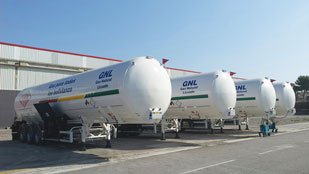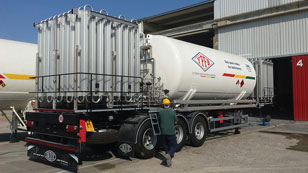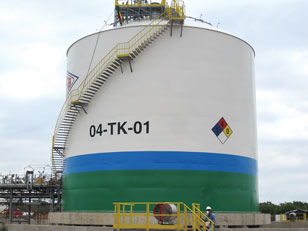Boxscore Construction Analysis
M. Nogarin, Contributing Writer
Bolivian state energy company Yacimientos Petrolíferos Fiscales Bolivianos (YPFB) is the largest natural gas supplier in South America. It exports 33 MMm3/d of natural gas to Brazil and 16 MMm3/d of gas to Argentina, for a total of 49 MMm3/d.
 |
|
Fig. 1. Tanker trucks for loading and delivery of LNG from |
The construction of a new LNG virtual pipeline network will help diversify supply routes for Bolivia’s gas. The network includes a fleet of cryogenic transport tanker trucks (Fig. 1) and mobile regasification units (Fig. 2), in addition to 27 satellite regasification facilities.
 |
|
Fig. 2. A mobile regasification station for the LNG virtual |
Scope of virtual network. The LNG virtual grid extends from YPFB’s 210-tpd LNG plant in the Rio Grande region, which commenced operations in early 2016 and was constructed by a consortium formed by Spanish Sener’s technology and engineering group. Sener also provided design, construction and startup of the virtual pipeline network.
The LNG transported by tankers is stored and regasified in the 27 satellite stations. Once regasified, the gas passes through a control unit and metering and odorization stations, and is then sent through networks of gas distribution for final consumption.
The virtual pipeline will supply LNG to the towns of San Julian, San José de Chiquitos and Tupiza. These cities are located far from the gas pipeline networks of Santa Cruz and Potosi, and the connection via the virtual grid will help provide necessary gas supplies to their residents and businesses. YPFB plans to expand LNG deliveries to an additional 33 municipalities at a later date.
The virtual grid is also expected to boost employment and promote the establishment of natural gas vehicle stations.
LNG plant design. In preparing the LNG for transport, natural gas is cooled to a temperature of –161°C to form a liquid at atmospheric pressure. The complexity of the liquefaction plant in Rio Grande is heightened by the quality of the feed natural gas, which is determined by the CO2 content.
A potential danger of CO2 solidification at cryogenic operating conditions exists. Therefore, the CO2 content in the natural gas stream must be reduced below 50 ppmv to avoid damage to the aluminum heat exchanger. A CO2 absorption process with amines (MDEA) is required to reduce the CO2 content in the feed.
Finally, the natural gas pretreatment process includes a system of sieves with zeolites, which removes water content and a fraction of the heavy hydrocarbons prior to sending the gas to the liquefaction stage. Retained water and hydrocarbons are removed from the sieve in a regeneration stage that uses a fraction (10%) of the main natural gas stream.
Natural gas purified from the pretreatment stage is sent to a brazed aluminum plate-fin heat exchanger installed in the cold box. Nitrogen is used as a refrigerant by means of a dual expansion process. The nitrogen operates in a closed loop, where it is initially compressed in a three-stage centrifugal compressor. The nitrogen is compressed again by a booster compressor, cooled with cooling water and then sent though the cold box to a turbine expander, where it is depressurized.
After depressurization, the nitrogen reaches cryogenic temperature and is sent back to the cold box to be used as a refrigerant to liquefy the natural gas. The nitrogen stream that exits the cold box is sent back to the recycling compressor suction, and the cycle restarts.
LNG storage and distribution. The LNG is stored in a 3,000-m³ cryogenic tank (Fig. 3) at atmospheric pressure and a temperature of –161°C. From this tank, the LNG is pumped to the truck loading stations. The LNG filling flowrate is a batch process and depends on the loading station demand.
 |
|
Fig. 3. Cryogenic tanks for LNG storage. |
The trucks transport the LNG to the satellite regasification stations for subsequent vaporization and delivery. The Rio Grande LNG plant is provided with two truck loading stations that allow 10 tanks to be filled daily. GP




Comments